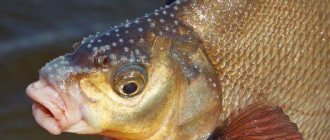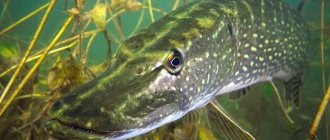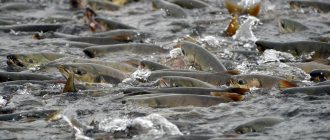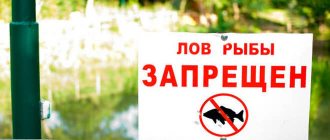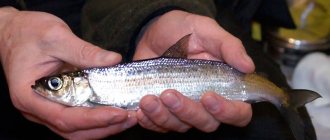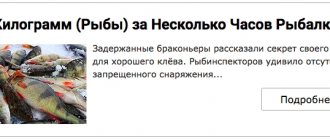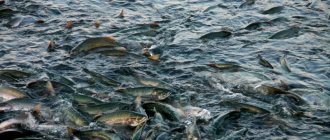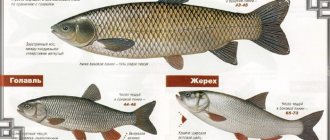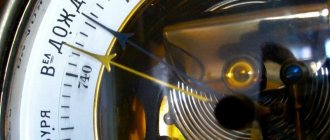Poaching in Russia is an acute environmental problem. All segments of the population are involved in this criminal business. The consequences of thoughtless destruction of fish in rivers and lakes today can lead to a catastrophic disruption of the ecological balance in decades. Therefore, laws protecting nature are becoming stricter, and measures to combat poachers are being strengthened. There are many fishing tools and devices, and fishing enthusiasts should know which ones are considered river poacher's gear and may result in prosecution.
What gear is considered poaching?
The poachers' arsenal includes ancient tools, such as a siege - a thick rope with floats and hooks that tear the gills, which was banned 300 years ago as a means of preventing spawning - and modern ones - air guns and firearms.
Great harm is caused by:
- tyrants - sinkers with large treble hooks;
- “ware” is a tackle invented by poachers specifically for catching sturgeon, which cripples the fish;
- catfish, in many ways similar to the sterlet feather.
The use of poisonous and explosive substances is prohibited. When the last 10% of the fish is used, it floats to the surface, and poachers collect it with nets, and 90% of the wounded and killed individuals lie on the bottom of the reservoir. You cannot use pokes or other passive weapons on rivers where salmon fish live.
When and how is fishing prohibited?
The government of each region sets its own deadlines, in accordance with which fishermen are prohibited from fishing. These dates may change each year depending on weather conditions. Fishing is prohibited during fish spawning.
In addition, it is important to know that fishing with highlighting and hooking is prohibited. Silencing prey or using firearms or electricity is also unacceptable. Installed fences that interfere with the free movement of fish are considered poaching.
Webs and spiders
Poaching nets include the following types of nets:
- Dragging (or dragging). Tackle up to 50 m long, which is brought into the water, held by poles attached to the side parts (wings) and pulled along the ford in shallow water. The net covers an area of the reservoir, driving everything that comes across into a special bag-trap (motnu). Brednem is often used in the spring during floods.
- Seine. It looks like a large nonsense, more than 100 m long. It is not launched, but thrown into the water from boats.
- A fixed net is the most common poacher’s gear on the river. The greatest damage is caused by “Chinese”, woven from fishing line. It has small cells and catches everything from the reservoir, including frogs and ducks. This net is cheap; often when fishing ends, poachers leave it in the water, where it can remain in working condition for many years. The inhabitants of the rivers get entangled in it and die.
- Floating net. The special design lifts bottom-dwelling fish. Mainly used on rivers with strong currents to catch particularly valuable species.
- A network with ryazh, i.e. with large cells. Woven from nylon thread. It destroys medium and large fish.
- "Track". The gill net is lowered into the water (in the direction of travel) and returned to the shore using an elastic band. The poacher is on the shore, releases it, and the “path” blocks the fish’s path.
- “TVs” are screens made of installed 10-15 grids.
A tackle prohibited in Russia - a spider lifting net - is a rectangular sheet with 2 arcs attached to the corners diagonally. At the place where they intersect there is a ring for a rope, with the help of which the tackle is suddenly lifted. Food is placed in the central part of the net. They use “spiders” on piers and high banks. It causes great damage during spawning, when the water is still cloudy and the fish’s attention is dulled, and it enters the lift without fear.
In addition to those listed above, the following straining and entangling (entangling) poaching gear is used: “grips”, “drills”, “bastings”, “capes”, “shards”, “kerchiefs”, “cutters”, “ohanas”, various types of valves ( “merezhi”, “zhaki”, “muzzles”, “kubyri”, “kutki”, “winged”), etc.
Nets can only be used in some regions of the country (in the Far East, Siberia, the North) with a license issued by Rosrybolovstvo, after registration and individual marking of the nets indicating all the owner’s data. Poaching methods of catching fish in winter in most cases involve the use of seines, when the catch is scooped out with a net from a net, or a narrow and long net with weights, designed to entangle the fish with gill covers. These gears are depriving water bodies of a future. For winter fishing, no structures other than windproof ones must be installed on the ice of fishing facilities.
Permitted gear and fishing methods
All citizens of the Russian Federation can engage in recreational and sport fishing for personal consumption on public water bodies free of charge.
For members of societies the following rules of recreational fishing:
- summer and winter fishing rods with a total number of hooks of no more than 10 pieces (no more than 3 on a fishing rod);
- spinners;
- girders;
- circles (up to 5 hooks per fisherman or boat;
- spinning rods and fly fishing.
Rules for recreational fishing for non-members:
- summer and winter fishing rods with a total number of up to 5 hooks (no more than 3 on a fishing rod);
- spinners;
- girders;
- circles (no more than 3 hooks per fisherman or boat);
- spinning and fly fishing.
There are also restrictions (recreational fishing rules) on the number of gear of various types, for:
- A fisherman in a society - three different types of gear.
- For anglers who are not members of the public – two different types of gear.
When fishing from a boat:
- Members of societies - 6 tackles;
- Members of non-societies - 4 tackles, provided that there is more than one angler on the boat.
| Name of aquatic biological resources | Allowable size, cm |
| Asp | 40 |
| Zander | 40 |
| Pike | 32 |
| Som | 90 |
| Carp | 40 |
| Burbot | 40 |
| Chub | 20 |
| Cancer | 10 |
Harpoons
Piercing weapons - a pike, a spear, a harpoon in the hands of a poacher turn into an instrument of cruel slaughter, they injure a large number of individuals, and they pose a danger to the entire livestock.
The exception is spearfishing using a speargun. The harpoon for it is made of spring steel and has a removable tip in the form of a bullet and a barb. The use of scuba gear during spearfishing is considered poaching. You can only dive with oxygen in your lungs.
Fishing places and types
Fishing rules divide water bodies into two types - public use and cultural fisheries. In the latter, you can catch sport fishing objects, but you must obtain a fishing license. Mining in them is carried out on a paid or free basis. Members of specialized societies may be issued vouchers, which entitles them to preferential conditions.
Fishing for bream - the right choice of place, tackle and bait

Currently, the following types of fishing exist:
- Amateur. The main sign is that the production will not be used as an object of sale in the future. Each region determines what can be fished with and a ban on activities during the spawning period.
- Sports. The goal is to catch fish of a certain species with maximum weight and size. To do this, they go to the sport fishing site, pre-issue a permit, a fishing ticket, and draw up regulations based on the current legislation.
- Promyslovaya. The peculiarity is the commercial component. The fish goes on sale. The type of prey is determined - red, white or black. After the license is issued, a ban on fishing for other types of fish automatically applies. In this case, it is permitted to catch a permissible minimum amount of a type of fish not specified in the license.
These types of fisheries also differ in the periods of prohibition of activities, fishing rules and the gear used. They are described on the Rosrybolovstvo website, but it is recommended to check the details at the local branch of the organization.

Electric fishing rods
This poacher's tool looks like a large net with electrodes attached to the rim, which is a converter of electrical current coming from a car battery. It can operate within a radius of 10 m, completely destroying valuable and rare species of fish of all age groups. If the field is strong, they die immediately; with a current of medium strength, they begin to move along the tension lines - towards the anode (net) and, approaching it, are paralyzed (put to sleep) by the strong field.
Different species react differently to electric current. For example, tench goes to depth, pike perch remains at medium depth, catfish and burbot emerge from their shelters. Trout and grayling float and lie on the surface for a long time, so their populations suffer the most.
As a result, the bottom of the reservoir can be strewn with small specimens, and the one that does not die is rendered sterile by the current, that is, incapable of reproduction. It may harm animals or people nearby. In addition, the current kills insect larvae, leaving the fish without food. Representatives of supervisory authorities can determine by the type of prey that an electric fishing rod was used when catching it, for example, by spots on the sides that look like burns, or a change in color (in trout).
Prohibited items include the rubber bottom fishing rod, a poaching tackle on which a mesh screen is placed instead of hooks, as well as fishing rods and spinning rods of any type and design with a total number of hooks of more than 10 per person. Fishing is prohibited during spawning season. It is considered illegal to catch pike even with a spinning rod from the shore. The spawning period in different regions has its own timing, they need to be clarified.
Exact prohibitions
Every angler must know and adhere to the rules of sport and recreational fishing. The time of spring spawning in different regions of the country can vary significantly. Therefore, before going fishing in the spring, it is advisable to clarify in advance the time frame for which the ban on spinning fishing has been introduced in your region. Why can’t you fish even from the shore?
Precisely because the pike comes very close to the shore, and also after throwing eggs, it begins to actively feed and loses all vigilance, as it pounces on any prey, and a spawning ban has been introduced.
In general, throughout the country the ban on pike fishing lasts from early spring until the first days of the summer month. The main reason for this is to allow the natural production of offspring to occur under normal and safe conditions.
During fish spawning in the spring, certain fishing standards apply.
Thus, fishing is strictly prohibited:
- with nets (as at any other time), as this is considered poaching;
- fishing with a float rod and donka is prohibited if it has more than three hooks or a hook larger than 10;
- spinning fishing;
- It is prohibited to use more than one fishing rod per person (spinning is completely prohibited);
- use of any floating craft with a motor.
But not everything is as bad as it might seem at first glance. And fishing, although with some restrictions, is still possible.
So, you can fish during spawning:
- from the shore;
- using one rod or donka with one hook;
- the hook should be no more than size 10 according to international standards;
- only during the daytime.
Despite the strict restrictions, using only the listed fishing methods, you can have a good time and catch your long-awaited trophy.
All restrictions and prohibitions on spinning fishing, as well as the number of rods, time for fishing and other restrictions are automatically lifted after the completion of fish spawning. The deadline for lifting the ban is mid-June.
During spawning in reservoirs, there is a high concentration of various fish species near the coastline. In this regard, in addition to pike fishing, there is a ban on fishing other types of fish with a spinning rod.
Each region of Russia has a list of prohibited species of aquatic biological resources. In the Moscow region these include:
- sterlet;
- trout;
- catfish;
- grayling;
- subdust;
- white-eye;
- blue;
- saberfish;
- bersh;
- lamprey;
- cancer.
And here's what you need to know: Pike biting forecast in the village of Elizavetino
For other regions of the country, the lists of fish subspecies prohibited from catching should be clarified with local fisheries authorities.
Please note that you can receive a fine for fishing with a spinning rod in some areas of rivers and reservoirs, since fishing by any means is prohibited there.
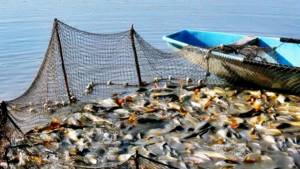
Here are just some of the large bodies of water:
- In the city of Dubna, downstream of the Volga, at a distance of 1 kilometer from the dam.
- Pestovskoye, Istrinskoye and Klyazminskoye reservoirs.
- Lutosnya River.
Some fishing spots in these reservoirs are still allowed. For clarification, you also need to contact special authorities.
In order not to spoil your fishing holiday, especially during the spring spawning, and not to become a poacher out of ignorance, do not use various gear that increases the volume of fish caught. If you are going to any body of water, try to find out as much as possible about it: what fish can be caught in it and what cannot be caught, what maximum weight you are entitled to.
During spawning, do not break the “month of silence”. Do not litter, do not park cars on the shore, do not use water transport, avoid yourself and do not allow anyone to poach. In a word, take care of the surrounding nature so that tomorrow your children can enjoy all the delights of a good rest and fishing.
The Law on Amateur Fishing stipulates that amateur fishing is incompatible with any poaching fishing gear. Among the people, among lovers of easy money and illegal fishing, in order to somehow justify their actions and mislead other fishermen, there is one simple phrase in use: “Everything that is not prohibited is permitted.”
Unfortunately, there are many poachers on water bodies, for whom the sense of profit is more important than the rules of the law, ethics, morality, conscience, decency and honor.
Fishing rules prohibit production (catch) with any fishing (catch) gear, with the exception of:
- summer and winter fishing rods of all modifications with a total number of hooks of no more than 4 pieces on fishing gear for one citizen.
- fly fishing rods, spinning rods, using spinners, wobblers, flies and other baits.
- fishing with a “boat”, with a total number of hooks of no more than 4 pieces.
- zherlitsy and circles with a total number of no more than 2 pieces per citizen.
- nets (bait hook gear) and casting fishing rods (“throwbacks”), including the use of rubber shock absorbers, with a total number of hooks of no more than 4 pieces on the fishing gear of one citizen.
- fishing on the track (trolling).
- special pneumatic guns (pistols) and crossbows for underwater hunting without the use of scuba gear and other self-contained breathing apparatus for the purposes of amateur and sport fishing.
It is prohibited to be on a body of water or in its immediate vicinity with prohibited fishing gear. For violation of fishing rules, the law provides for material, administrative and criminal liability.
The violator is subject to a large fine with confiscation of poaching tools and fishing equipment, or restriction and even imprisonment. In addition, fisheries authorities have the right to bring a large claim for damage caused by illegal fishing.
Poachers who commit repeated violations or resort to predatory fishing methods (explosives, firearms, toxic substances, etc.) are subject to criminal liability.
Author of the article: Team of authors of the site orybe.com 2014-03-15
orybe.com
Therefore, it is recommended to take into account all the features of the upcoming fishing. In Russia there are currently restrictions regarding this process. For example, on how and where not to bring an idea to life.
All of the above does not mean that there is nothing to be afraid of. In fact, an amateur fisherman will still have to follow certain rules during spawning. Otherwise, he may be fined, as well as confiscate the fishing gear and other devices that were involved.
And here's what you need to know: The best methods for catching crucian carp in the spring - features and tricks
Is it possible to fish with a spinning rod when it is prohibited? Yes, amateurs have the right to do this. You just need to follow a number of generally accepted rules. If they are not taken into account, then the citizen has the right to be fined. Not for the direct use of a spinning rod, but for some other reason.
What fines may be imposed in this or that case? In Russia, fishermen most often encounter the following cases:
- Fishing during spawning. It is punishable by payment of up to 30,000 rubles. The exact amount will be announced in a specific region for each case.
- Catching carp, pike, crayfish and bream in the spring, during the spawning period. In this situation, everything depends on the number of individuals caught. Crayfish will cost 42 rubles, bream - 25, carp, pike and carp - 250 rubles per fish.
- For parking a vehicle (most often a car) near a body of water, a payment of up to 4,000 rubles is required. The exact amount is set at the regional level.
- The use of prohibited fishing means causing damage on a large scale will entail a fine of 100 to 300 thousand rubles. Or you can wait for arrest for up to six months.
These are not all fines, but those listed are the most common. Most payments are governed by the rules of a particular region.
Legislative prosecution of poaching
If you are interested in the question of who poachers are, then these are people who use barbaric methods and devices for catching fish, listed in legal acts. In Russia, liability for poaching is provided for in Articles 256, 258, 260 of the Criminal Code of the Russian Federation, as well as 8.28 and 8.37 of the Code of Administrative Offenses of the Russian Federation. Aggravating factors are:
- commission of a crime by a group of persons;
- damage on a large and especially large scale;
- use of official position.
In 2021, a fine of up to 300 thousand rubles will be imposed for illegal fishing that causes damage on a large scale. or correctional labor for up to 2 years, and by a court decision, 2 types of punishment can be imposed simultaneously. It is believed that poachers cause particular damage to rivers during spawning. The amount of the fine imposed depends on the type of fish:
- For catching carp, carp or pike during spawning, a poacher will pay 250 rubles. for each individual;
- for cancer - 42 rubles;
- for bream - 25 rubles;
- for each female the amount increases 2 times;
- for each individual whitefish or salmon species, the amount of the fine increases an additional 3 times.
The catch limit depends on the region and type of fish. Fishing gear, devices and vessels of poachers are subject to confiscation.
Fine for catching prohibited species of fish or crayfish
For the information of fishermen, in each region there is a list of species of aquatic biological resources prohibited for extraction (catch), and the minimum size of extracted (caught) aquatic biological resources (permissible size) is also determined.
Let us remind you that according to the fishing rules, the following types of fish are prohibited for fishing in the waters of Moscow and the Moscow region: sterlet, trout, catfish, grayling, podust, white-eye, blue bream, sabrefish, bersh, lamprey and crayfish.
When fishing for pike perch, bream, pike, burbot and some other types of fish, there are restrictions on their size. By law, you must release them back into the pond.
You should also look for these lists in the Fishing Rules for each individual fishing basin. How to catch crayfish, when you can catch crayfish: Catching crayfish with a crayfish trap.
Why is it important to protect ichthyofauna?
Poaching methods and fishing gear lead to a biological imbalance in all ichthyofauna systems:
- snakes, aquatic rodents, and shellfish die; when they rot, the water becomes poisoned, and parasites are spread throughout the reservoir;
- when a large number of silver carp and grass carp are destroyed, the reservoir quickly becomes overgrown with algae and shells, and the water becomes dirty;
- The destruction of the frog population leads to the appearance of a mass of mosquitoes that can carry diseases.
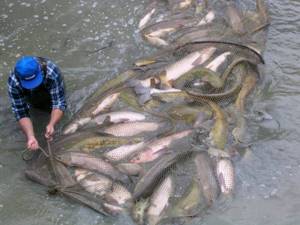
Dirty water is dangerous for ichthyofauna, waterfowl, people, and animals. Due to overfishing in water bodies, the population of all types of fish is declining, many of them may disappear. Small bodies of water suffer the most.
Fish catch rate in Russia in 2021
The daily allowable catch rate per person is five kg per day, except if the weight of one piece is greater.
Read also: Law on business partnerships in 2021
If fishing lasts for several days, then their number is multiplied by this norm.
The quantitative standardized indicator reaches 30 pcs. per day per citizen. This applies to the following fish:
- pike perch and carp;
- grass carp and catfish;
- silver carp.
The standard catch rate for animal species differs by region.
Catch rates
The law regulates the maximum permissible mass of prey. For members of the Society of Hunters and Fishers it is 5 kg, for all others - 3 kg. This is the daily norm, but if your stay on the reservoir takes more than 24 hours, it is allowed to exceed the norm twice. A list of prohibited species has been compiled for each fishery.
Additionally, the following characteristics are taken into account:
- the minimum permissible size is regulated for each type of fish;
- weight.
If these parameters are less than acceptable, the prey should be released into its habitat with minimal damage. Most often, these standards are indicated in the fishing permit or in the permit for spearfishing. As an example, it is recommended to familiarize yourself with the data in the table, which shows the permitted fish species.

To measure the length of crustaceans, take the distance from the eyes to the end of the tail plates. This applies to crayfish; amateur crab fishing in Russia is prohibited.
How to make a fishing box for winter fishing with your own hands: selection of materials and manufacturing procedure


